The phylogeny of the red panda (Ailurus fulgens): evidence from the forelimb
- PMID: 19930516
- PMCID: PMC2796785
- DOI: 10.1111/j.1469-7580.2009.01156.x
The phylogeny of the red panda (Ailurus fulgens): evidence from the forelimb
Abstract
Within the order Carnivora, the phylogeny of the red panda (Ailurus fulgens) is contentious, with morphological and molecular studies supporting a wide range of possible relationships, including close ties to procyonids, ursids, mustelids and mephitids. This study provides additional morphological data, including muscle maps, for the forelimb of Ailurus, based on the dissection of four cadavers from the National Zoological Park, Washington, DC, USA. The red panda forelimb is characterized by a number of primitive features, including the lack of m. rhomboideus profundus, a humeral insertion for m. cleidobrachialis, the presence of mm. brachioradialis, articularis humeri and coracobrachialis, a single muscle belly for m. extensor digitorum lateralis with tendons to digits III-V, four mm. lumbricales, and the presence of mm. flexor digitorum brevis manus, adductores digiti I, II and V, and abductor digiti I and V. Red pandas resemble Ailuropoda, mustelids and some procyonids in possessing a soft tissue origin of m. flexor digitorum superficialis. In addition, red pandas are similar to ursids and procyonids in having a variable presence of m. biceps brachii caput breve. Furthermore, Ailurus and some ursids lack m. rhomboideus capitis. The forelimb muscle maps from this study represent a valuable resource for analyzing the functional anatomy of fossil ailurids and some notes on the Miocene ailurid, Simocyon batalleri, are presented.
Figures
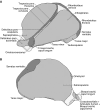

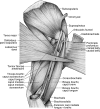





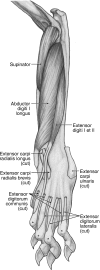
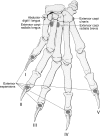
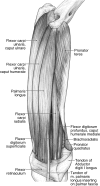


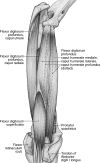

References
-
- Allen H. The muscles of the limbs of the raccoon (Procyon lotor) Proc Acad Nat Sci Philadelphia. 1882:115–144.
-
- Beddard FE. On the visceral and muscular anatomy of Cryptoprocta ferox. Proc Zool Soc Lond. 1895:430–437.
-
- Beddard FE, Treves F. On the anatomy of Rhinoceros sumatrensis. Proc Zool Soc Lond. 1889;1:7–25.
-
- Beswick-Perrin J. On the myology of the limbs of the Kinkajou (Cercoleptes caudivolvulus) Proc Zool Soc Lond. 1871:547–559.
Publication types
MeSH terms
LinkOut - more resources
Full Text Sources

